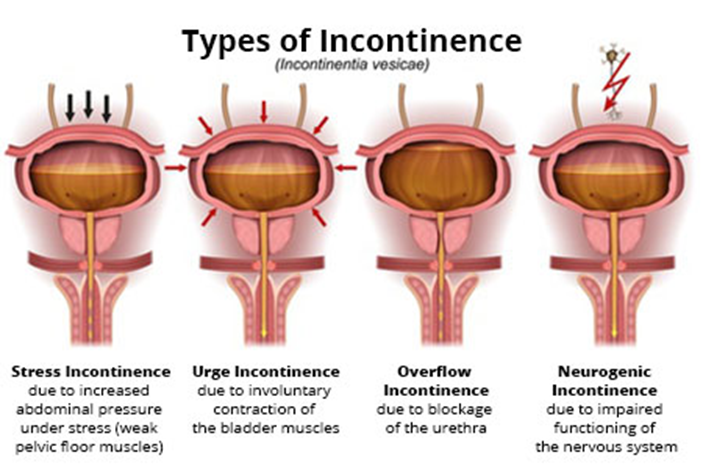A nurse is caring for a client who tells the nurse she experiences urinary incontinence when she sneezes. The nurse recognizes this is an expected finding for which of the following types of incontinence?
Stress incontinence
Urge incontinence
Overflow incontinence
Reflex incontinence
The Correct Answer is A
A. Stress incontinence
Stress incontinence is the involuntary loss of urine during activities that increase intra-abdominal pressure, such as sneezing, coughing, laughing, or lifting heavy objects. In stress incontinence, the pelvic floor muscles are weakened, leading to inadequate support of the bladder and urethra. This results in leakage of urine during moments of increased pressure on the bladder.
B. Urge incontinence
Urge incontinence involves a strong and sudden urge to urinate, leading to involuntary urine loss. It is often associated with an overactive bladder and may not be related to increased abdominal pressure.
C. Overflow incontinence
Overflow incontinence occurs when the bladder is unable to empty completely, leading to constant dribbling of urine. It is often associated with conditions that obstruct urine flow, such as an enlarged prostate in men.
D. Reflex incontinence
Reflex incontinence is characterized by the involuntary loss of urine due to a reflex arc that bypasses normal control mechanisms. It is often associated with neurological conditions that affect bladder control.

Nursing Test Bank
Naxlex Comprehensive Predictor Exams
Related Questions
Correct Answer is D
Explanation
A. Yogurt:
Yogurt is not a significant source of iron. While yogurt provides various nutritional benefits, it is not considered an iron-rich food.
B. Oranges:
Oranges are a good source of vitamin C, which enhances the absorption of non-heme iron from plant-based foods. However, oranges themselves do not contain substantial amounts of iron. The combination of vitamin C-rich foods with iron-rich foods can be beneficial for iron absorption.
C. Turnips:
Turnips are a vegetable that, while nutritious, is not particularly high in iron. Additionally, the iron in plant-based foods like turnips is non-heme iron, which is less easily absorbed by the body compared to heme iron found in animal products.
D. Roast beef:
Roast beef is a good source of heme iron, which is more easily absorbed by the body. Red meat, such as roast beef, is a valuable dietary source of iron, especially for individuals with iron deficiency.
Correct Answer is A
Explanation
A. Stress incontinence
Stress incontinence is the involuntary loss of urine during activities that increase intra-abdominal pressure, such as sneezing, coughing, laughing, or lifting heavy objects. In stress incontinence, the pelvic floor muscles are weakened, leading to inadequate support of the bladder and urethra. This results in leakage of urine during moments of increased pressure on the bladder.
B. Urge incontinence
Urge incontinence involves a strong and sudden urge to urinate, leading to involuntary urine loss. It is often associated with an overactive bladder and may not be related to increased abdominal pressure.
C. Overflow incontinence
Overflow incontinence occurs when the bladder is unable to empty completely, leading to constant dribbling of urine. It is often associated with conditions that obstruct urine flow, such as an enlarged prostate in men.
D. Reflex incontinence
Reflex incontinence is characterized by the involuntary loss of urine due to a reflex arc that bypasses normal control mechanisms. It is often associated with neurological conditions that affect bladder control.

Whether you are a student looking to ace your exams or a practicing nurse seeking to enhance your expertise , our nursing education contents will empower you with the confidence and competence to make a difference in the lives of patients and become a respected leader in the healthcare field.
Visit Naxlex, invest in your future and unlock endless possibilities with our unparalleled nursing education contents today
Report Wrong Answer on the Current Question
Do you disagree with the answer? If yes, what is your expected answer? Explain.
Kindly be descriptive with the issue you are facing.
